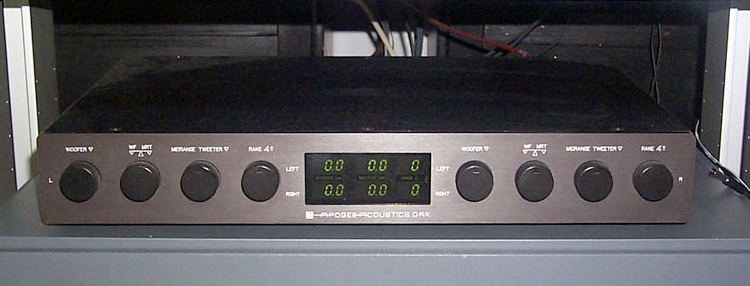
Detailed Info about the Apogee DAX Active Crossovers
DAX stands for Dedicated Active Crossover. Apogee made a few models and I’m not entirely sure that I have seen them all but there were at least 4 models: the more or less universal DAX 1 and DAX 3, and dedicated ones for the Mini Grand (Stage + Subwoofer) and Studio Grand.
DAX 1
Original price in 1990 $3995
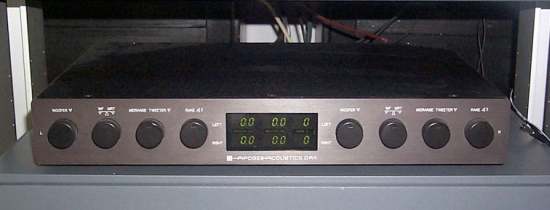
The DAX 1 is said to be the first Apogee Active Crossover. However, there was also a three way crossover available for the Full Range (AKA The Apogee) by the name of “Active Crossover”. More about that unit below. The DAX-1 however is the first Apogee crossover that went by the name of DAX. It is a more or less universal unit that can be used with the Diva, Caliper Signature and Duetta Signature. Inside the unit are switches that determine the filter curves for these models. Also inside are switches for single ended/balanced mode as well as 10-step input impedance selectors. Lastly, there are independent six-step woofer and mid/tweeter attenuator switches for amplifier gain matching. The balanced and unbalanced outputs for the Midrange/Tweeter and Woofer sections work regardless of the input type.
The DAX 1 came with an outboard power supply.
Please be warned that the passive crossovers need to be rewired in order to be used in conjunction with a DAX. So, if you buy second hand speakers that were always used with a DAX, don’t use the speakers without it, unless the passive crossovers have been wired back for use without DAX.
Clear wiring instructions can be found in the DAX manuals, available from the apogeespeakers.com website. Should the site be down and you are in need of a DAX 1 or 3 manual then just mail me and I will send you a copy.
DAX 1 Control functions
Woofer level 0 to -6dB in 1dB steps
Midrange/Tweeter level 0 to -6dB in 1dB steps
Woofer to Midrange/Tweeter balance fine adjustment -0.8 to +0.8 in 0.2dB steps
Rake, high frequency, or ‘brightness’ adjustment) (±2dB @ 5kHz, in 0.5dB steps hinged at 1kHz)
DAX 1 Specifications
Dual-channel dual-passband, non-inverting active crossover, with external power supply
Crossover frequency:
330Hz
Filter slopes:
6dB/octave gradually increasing to 12dB/octave
S/N ratio:
-90dB (A-weighted)
THD:
0.01%
Inputs and outputs:
balanced and single-ended.
Gain:
balanced=2, single-ended=1, with internal 6dB gain adjustments in 1dB steps for low- and highpass sections
Input impedance (switch -selectable)
balanced: 600,1.2k, 2.5k, 5k, 10k ohms; single-ended: 5k, 10k, 20k, 40k, 80k ohms
Output impedance:
6 ohms
Weight:
5.5lbs
Width:
18 inches
Depth:
12¾ inches
Height:
2½ inches
DAX 3
Original price $2995

The original price for the DAX 3 was $2995, $1000 less than the original DAX 1, which would seem to suggest that were different, but this is not the case. The main circuit boards are exactly the same, only the LED display and associated circuitry is removed.
As the main circuitry was not altered, there should be no sonic differences between the DAX 1 and DAX 3.
The DAX 3, like the original DAX 1, has internal switches to set the unit for use with the Diva, Duetta Signature and Caliper Signature. Internal switches also set the input type between balanced (XLR) or single ended (RCA), woofer to midrange/tweeter power amp gain matching and input impedance.
Please be warned that the passive crossovers need to be rewired in order to be used in conjunction with a DAX. So, if you buy second hand speakers that were always used with a DAX, don’t use the speakers without it, unless the passive crossovers have been wired back for use without DAX.
Clear wiring instructions can be found in the DAX manuals, available from the apogeespeakers.com website. Should the site be down and you are in need of a DAX 1 or 3 manual then just mail me and I will send you a copy.
DAX 3 Control Functions
(same as for the DAX1):
Woofer level 0 to -6dB in 1dB steps
Midrange/Tweeter level 0 to -6dB in 1dB steps
Woofer to Midrange/Tweeter balance fine adjustment -0.8 to +0.8 in 0.2dB steps
Rake, high frequency, or ‘brightness’ adjustment) (±2dB @ 5kHz, in 0.5dB steps hinged at 1kHz)
DAX 3 Specifications
(actually DAX 1 specs are shown but the should be the same for DAX 3)
Dual-channel dual-passband, non-inverting active crossover, with external power supply
Crossover frequency:
330Hz
Filter slopes:
6dB/octave gradually increasing to 12dB/octave
S/N ratio:
-90dB (A-weighted)
THD:
0.01%
Inputs and outputs:
balanced and single-ended.
Gain:
balanced=2, single-ended=1, with internal 6dB gain adjustments in 1dB steps for low- and highpass sections
Input impedance (switch -selectable)
balanced: 600,1.2k, 2.5k, 5k, 10k ohms; single-ended: 5k, 10k, 20k, 40k, 80k ohms
Output impedance:
6 ohms
Weight:
5.5lbs
Width:
18 inches
Depth:
12¾ inches
Height:
2½ inches
DAX for Mini Grand
Original price unknown
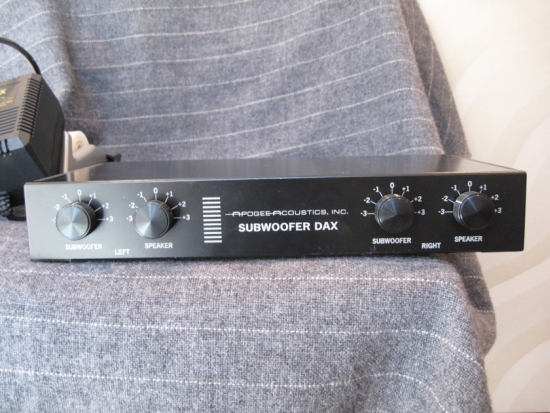
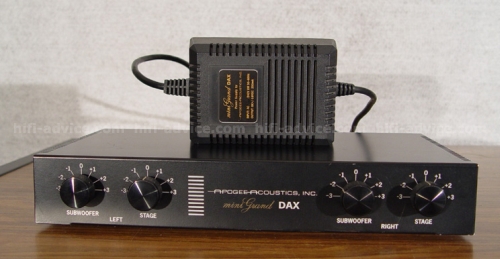
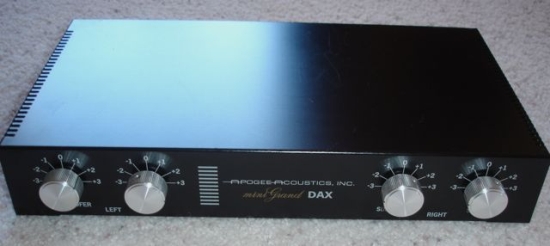
The Mini Grand DAX has been designed specifically for this application. The specified crossover frequency of the Mini-Grand DAX is 80Hz, with a rapid rolloff in the stop-band. Front-panel controls permit level settings of ±3dB on both the high- and low-pass sections, to accommodate individual setup needs and/or differing amplifier sensitivities.
The DAX is designed to be used in either balanced or unbalanced mode, to be chosen through internal jumpers.
Mini Grand DAX Specifications
Dual-channel, dual-passband, non-inverting active crossover, with external power supply.
Cross-over frequency:
330Hz.
Filter slopes:
6dB/octave gradually increasing to 12dB/octave.
S/N ratio:
-90dB (A-weighted).
THD:
0.01%.
Inputs and outputs:
balanced and single-ended.
Gain:
balanced=2, single-ended=1, with internal 6dB gain adjustments in 1dB steps for low- and high-pass sections.
Input impedance (switch-selectable)
balanced: 600, 1.2k, 2.5k, 5k, 10k ohms; single-ended: 5k, 10k, 20k, 40k, 80k ohms.
Output impedance:
6 ohms.
Front-panel controls (per channel):
for mid/tweeter level (0 to -6dB in 1dB steps), woofer and mid/tweeter balance (in 0.2dB steps), rake control ±2dB at 5kHz (in 0.5dB steps) hinged at 1kHz.
DAX for Studio Grand
Original price unknown
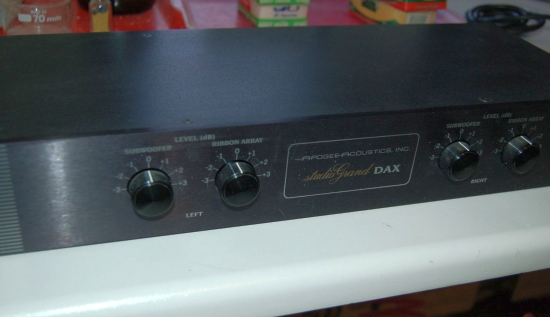
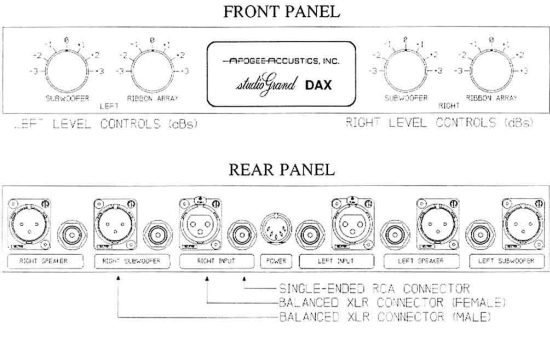
No further info available
Active Crossover
Original price unknown
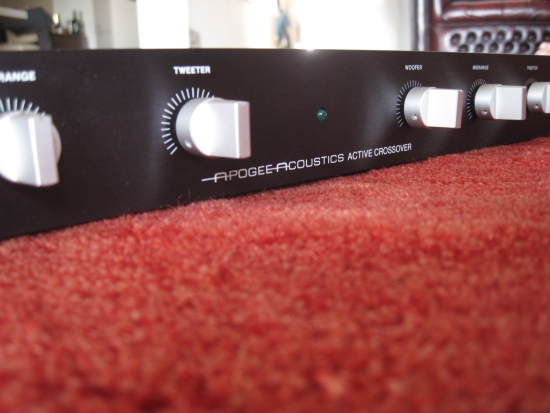
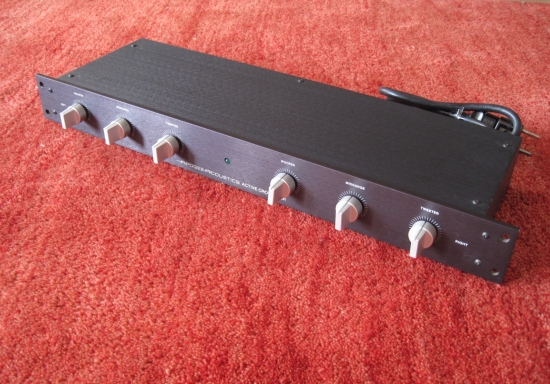
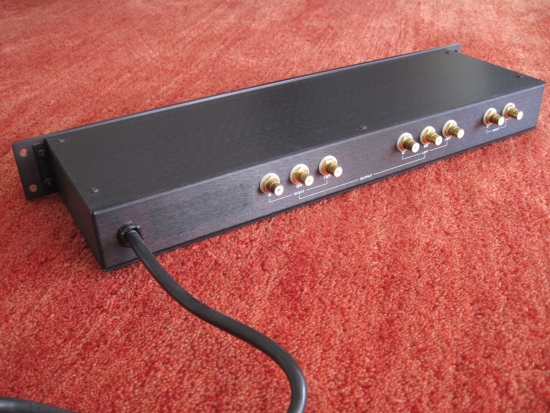
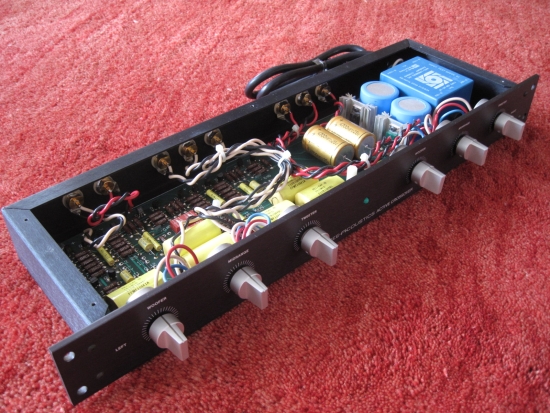
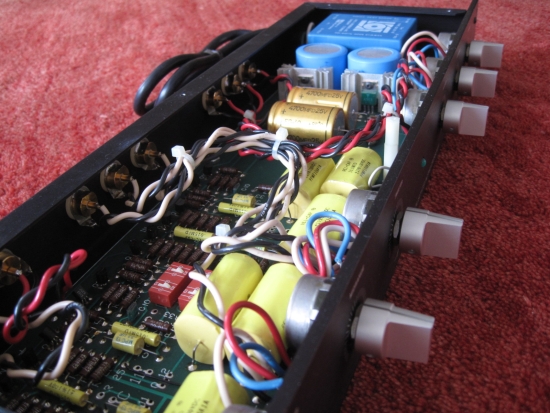
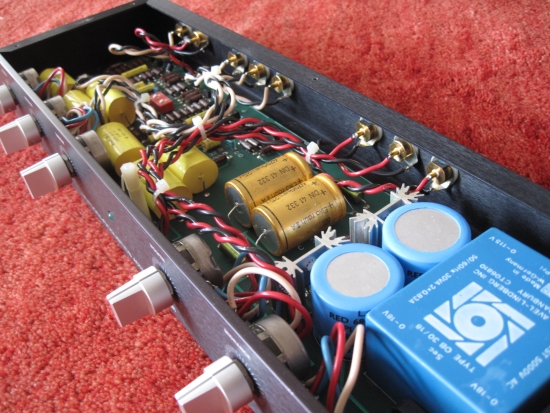
The “Apogee Active Crossover” was meant to be used with the Full Range but due to its internal switches, in theory it can also be used with other speakers, as long as the crossover frequencies match. I read somewhere that it can also be used with the Scintilla for example, and I used it myself with Divas, which went surprisingly well.
The unit is either a 2-way or 3-way crossover, depending on the setting of its internal switches. Further, the crossover frequency can be set to 400hz or 300hz. The crossover frequency between midrange and tweeter is set at 700hz.
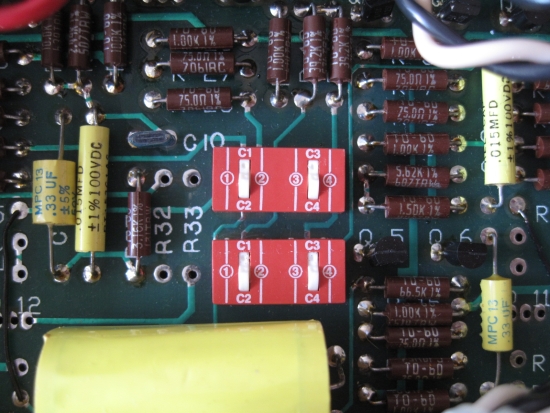

Above: careful… these notes, taken from the inside of the crossover’s top plate, may not be entirely correct, see below…
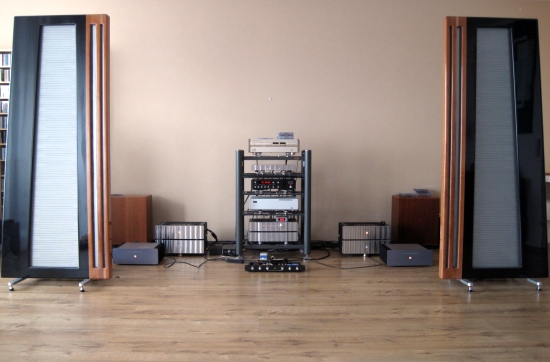
Observations when used with Divas
I carried out some testing with this crossover and my Divas. I will report more elaborately about the pros and cons of active versus passive crossover use and associated bi-amplification when the tests are complete but for now I’d like to just state my initial findings.
Although the drawing on the inside of the top cover states that the Bass/MR crossover frequency is set to 300hz with the C2+C4 bottom switches pushed down, and 400hz with these switches on off, strangely, my ears tell me that this is the other way around. Judging the midrange by itself without the other drivers attached, I clearly hear more upper bass from the midrange ribbon with the bottom switches toggled to C1+C3, and less midbass when they are toggled to C2+C4.
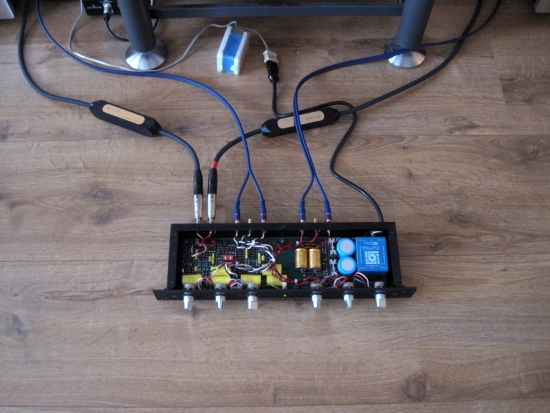
The bass outputs are always active and don’t seem to alter their crossover frequency in any way using any of the internal switches.
The midrange outputs are disabled when the internal upper switches are set to 2-way but are enabled when the switches are set to 3-way. Then, depending on the internal lower switches, the midrange either starts at 300hz or 400hz. This is clearly audible.
The treble outputs are always active but depending on the internal upper switches they start outputting 300/400hz or 700hz. Whilst the switch between 300/400hz and 700hz is clearly audible, I couldn’t tell any difference between the 300hz or 400hz setting of the bottom switches. It might be that the difference is less audible in the treble than it is in the midrange or my crossover might be defective, but either way, I couldn’t hear it. I strategically tested this using the Diva’s midrange driver in order to be sure that there was no excessive natural roll-off.
Inputs and outputs are cinch only.
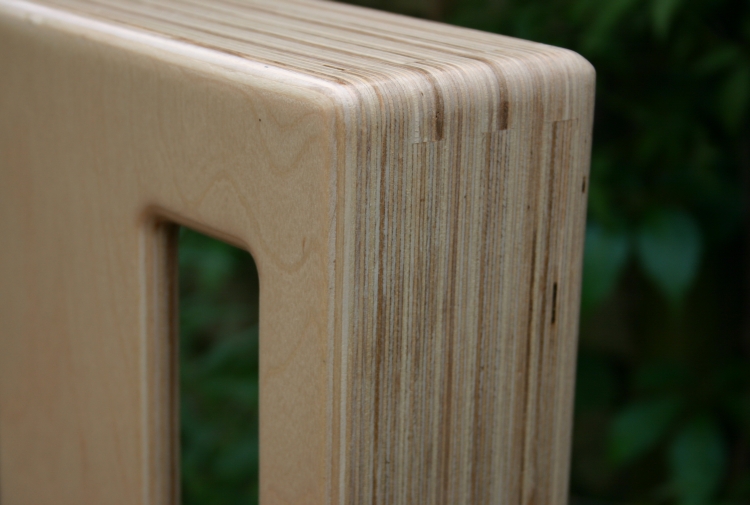
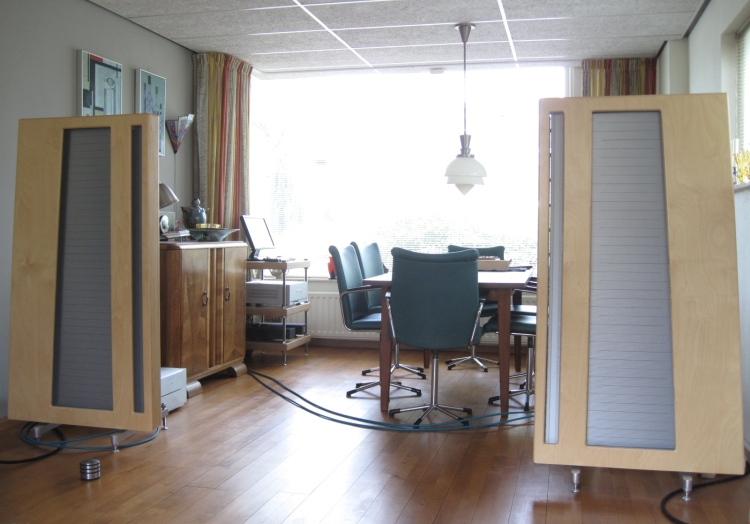
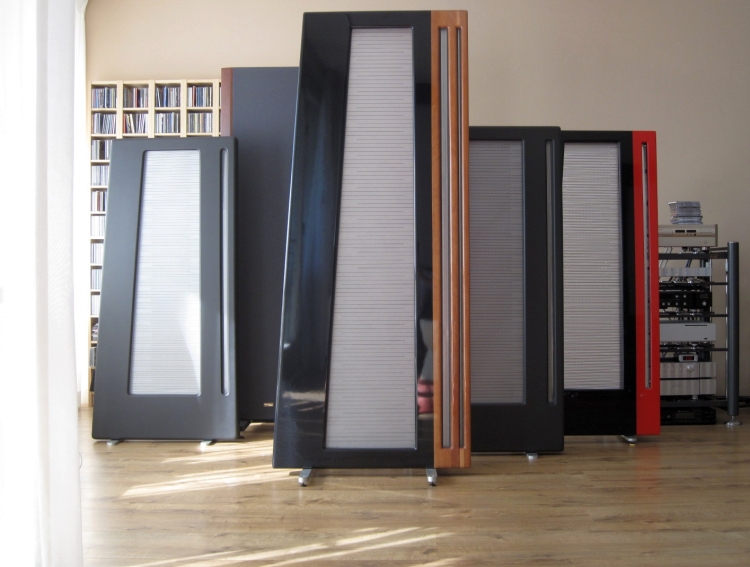
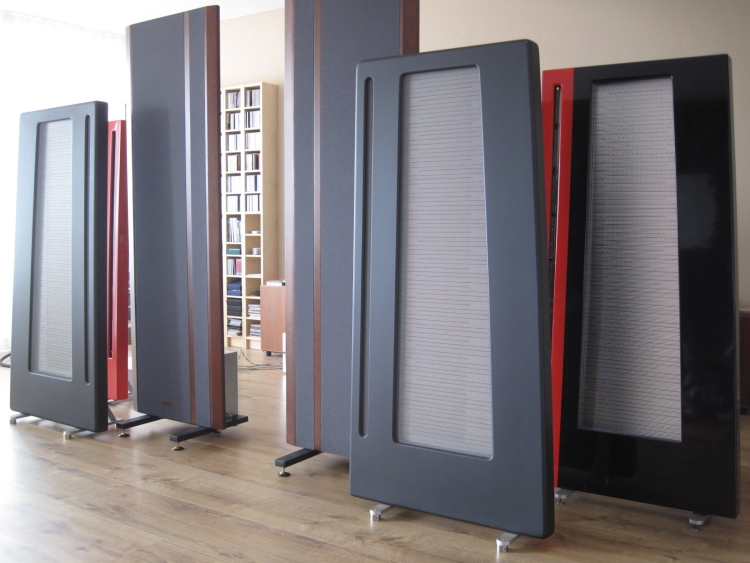
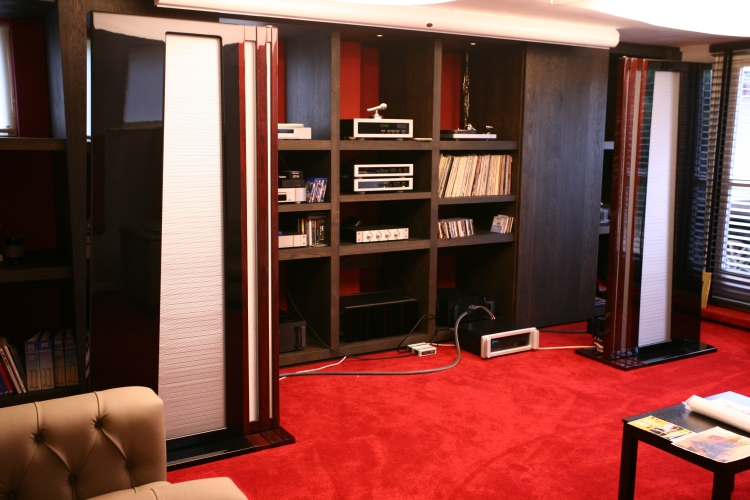
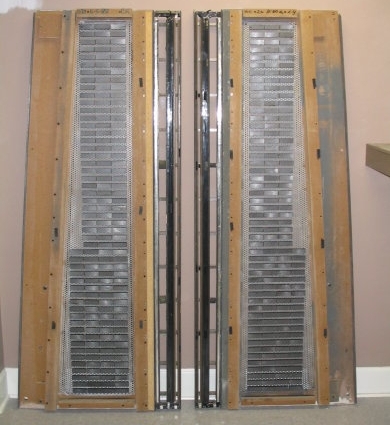
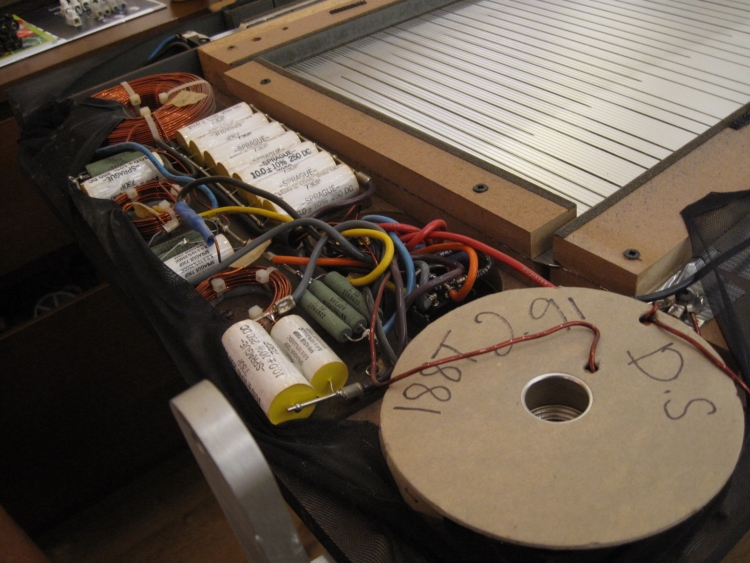
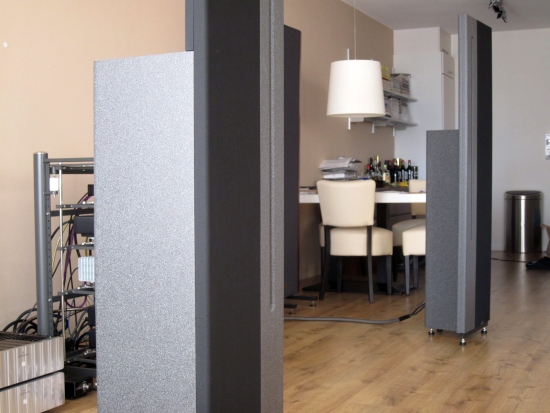
I know the balanced XLR wiring in the DAX 3 is pin-1 Ground, pin-2 Negative, pin-3 Positive. Does anyone know what the balanced wiring is on the Studio Grand Dax? Is pin-2 negative or positive on the XLR’s?
1 ground, 2 negative and 3 positive is one of the two possible connection schemes and this one is the less used incarnation. Classic Jeff Rowland gear used it before switching over and Spectral still does. You could say this is the original American method. More widely used is the German standard which is 1-ground, 2-pos, 3-neg. Depending on your amplifiers, you may need to create cross-wires or use the phase invert switch if you have one.
Ik heb nu meer dan 25 jaar apogee stages. Ze klinken nog steeds erg goed. Maar ik nu wil wel wat anders .
Is een mini grand DAX en twee svs subs een idee. En waar waar vind ik een DAX . Of zijn de stages verouderd en moet ik gewoon nieuwe speakers kopen.
Hi Menno, Stages have incredible bass and presence for a planar, especially for their size, and even today they remain competitive. If you want to change speakers but retain everything that’s so great about the Stages then I would advise sticking with Apogees. There are better speakers out there but they will cost many multiples of what you would spend on a decent pair of Apogees. My advice would be to stay away from active bi-amping and from the DAX for that matter. Also, I would not go down the rabbit hole of adding dynamic subs with a planar speaker. Sure you’d get more powerful bass but you won’t get the same coherence as you would with a full-range panel. Why not try a pair of Duettas? They remain my favorite “real-world” Apogees that are still easy to drive. It may come as a surprise, but they are actually easier to drive than Stages.
Hi Christian
Dank voor je antwoord.
Maar waar vind ik Duetta’s.
En ik lees in Stereophile dat de combinatie svs subs met zijn quad electostaten en electronisch filter wel goed werkt . Je belast het baspanel ook minder.
Check hifi.nl, marktplaats.nl, audiomarkt.de, hifishark.com.
Every crossover, active ones, too, introduces phase issues. If timing and coherence are important to you then no sub, no matter how great, will be truly ideal with Apogees. Besides, Duettas have incredibly deep and powerful bass already. When properly positioned I doubt you’ll find that you really need a sub anyway. Duetta bass panels move only very little so there is no need to divert bass away from them unless you play crazy-loudly.
Thank you for your message
But you talk like apogee duetta’s are still for sale . The are very hard to find. Especially a good pair.
If you know a good pair i am very interested.
Regards
Menno
Indeed, they are becoming rarer these days but many have been sold and many are still out there. These things just go in spurts, sometimes you see many of them only to see none for years. But with some patience, you should be able to find a pair sometime. Of course, there are alternatives if you’re looking for a dynamic speaker. For that, please check my speaker reviews. Graham Audio might be one idea.
I was more thinking in the direction of Finkteam Borg or Magico spekers.
I’ve not yet heard the Borg but I am a great fan of Magico, especially the S-range. Besides the Martin Logan ESL15A’s I use S1 mkII’s and I am very happy with them. It’s as they say: if you want many aspects of full-ribbon sound, Magico springs to mind. In fact, I find that the S1 mkII’s sound closer to Apogee Duettas than do many other planar speakers. But, admittedly, this comes at a cost. If cost is less of a consideration then I would recommend the S3 mkII which would be my speaker of choice if I did not have the Logans. You may also want to look at the MASTER Contemporary C, although I have not yet heard them in my own listening environment.
Thanks for your message
Hi Mr. Punter,
Thank you for this wounderful actical on the dax crossover it was very informative! I have recently acquired a dax (1) unit for use with my Divas, if possible could you please send me a copy of the manual? as mine didn’t come with one sadly.
Best Regards,
Brandon A.
Glad to hear it! Alas, I have no manuals of DAX units. I do have a manual of the Diva which I can mail to you if you don’t have it.
Ahh I see, the hunt continues. Thanks for getting back to me, I actually already have a manual for the Divas. Apparently there’s a copy of the manual for the dax 3 online, but not the 1, the boards are slightly different. Anyways thanks again Mr. Punter.
Best Regards
Brandon A.